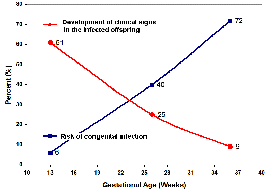Toxoplasma gondii is a protozoan parasite that infects most species of warm blooded
animals and can cause the disease toxoplasmosis. Members
of the family Felidae (domestic cats and their relatives) are the only known
definitive hosts in which Toxoplasma gondii may complete its life
cycle. Cats become infected after ingesting infected raw meat or oocysts. Recently infected cats shed large numbers of T. gondii oocysts in their feces. After 1 to 5 days the oocysts sporulate
and become infective.
Other animals including rodents, birds, sheep, goats,
pigs, and cattle, as well as humans may become intermediate hosts after ingesting material or water contaminated with the
infective oocysts.
The oocysts transform into tachyzoites
shortly after ingestion, and localize in neural and muscle tissue
where they develop
into tissue cyst bradyzoites. Tissue cysts remain in the intermediate host for life and are infectious to
other animals if the cyst-containing tissue is eaten.

|
As shown in Figure 1 to the left, transmission to humans may occur by several routes:
- Accidental ingestion of oocysts by exposure to soil or water that has been contaminated with
a cat's feces that contain Toxoplasma
- Ingestion of raw or undercooked meat that contains infective tissue cysts.
- Congenital infection from transplacental transmission
|
|
Figure1.Click to enlarge image |
The incubation period is 5 to 23 days after ingesting the infective cysts.
Most pregnant women who acquire the infection have no
symptoms. Some may
experience malaise, low grade fever, and lymphadenopathy. In particular
adenopathy of the deep cervical nodes. In some patients
symptoms may mimic infectious mononucleosis. Symptoms usually resolve without treatment within weeks to
months. Severe
symptoms, including myositis, myocarditis, pneumonitis
and paralysis may occur but are rare.
Prenatally acquired T gondii may infect the brain
and retina of the fetus and can cause chorioretinitis, intracranial
calcifications, and hydrocephalus. The frequency of vertical transmission increases with the gestational age
as shown in Figure 2. In contrast, severe
clinical signs in the infected infant are more commonly observed in offspring of
women whose infection was acquired early in gestation[1]
 |
Gestational Age at Maternal Seroconversion vs Risk of
Toxoplasma gondii Congenital infection and Development of Clinical Signs in
Offspring. Click to
enlarge image |
REFERENCES:
1. Montoya JG, Remington JS.
Management of Toxoplasma gondii infection during pregnancy. Clin Infect Dis 2008 Aug 15;47(4):554-66. PMID: 18624630